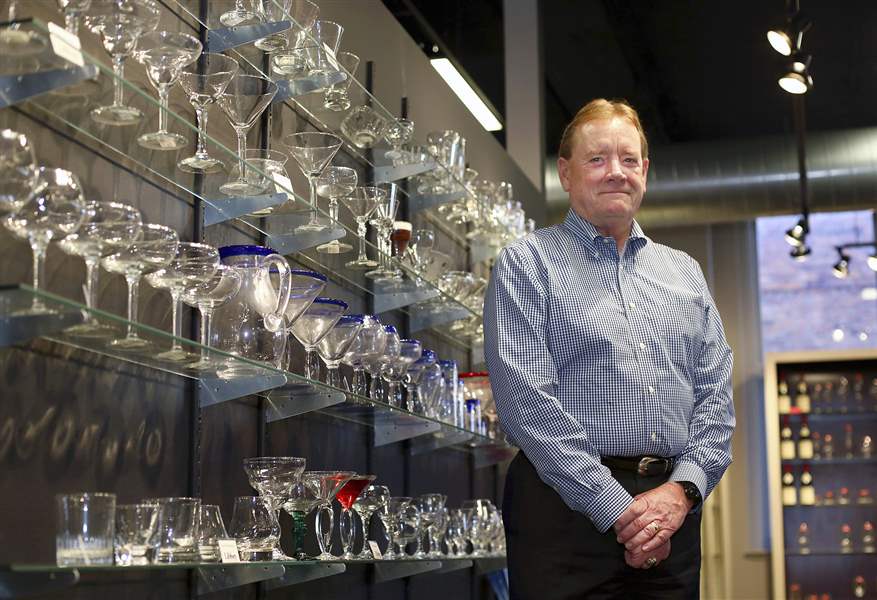
Libbey adjusting sales strategies
Glassware company finding more opportunities in e-commerce
6/18/2017
Chairman and Chief Executive Officer Bill Foley believes Libbey Inc. can sell more higher profit items using an in-house e-commerce system that can essentially be embedded within its retailers’ existing websites.
THE BLADE/AMY E. VOIGT
Buy This Image
Libbey Inc. is betting big on a new online sales platform that top executives say is crucial for shoring up its retail business and getting the company back on a growth track after several years of stagnant revenues.
“It is the most import single project we have inside the company today,” Chief Executive Officer Bill Foley said last week in an interview with The Blade. “It’s no secret that the American consumer, and frankly the European consumer and the Latin American consumer, are changing the way they buy.”

Bill Foley, chief executive officer at Libbey Inc., is launching a new online sales strategy for the glassware company.
By developing an in-house e-commerce system that can essentially be embedded within its retailers’ existing websites, Libbey hopes not only to regain sales opportunities that might be lost as shoppers skip the mall, but more importantly, have a better chance at selling higher profit items.
“The thing we’ve learned in doing the analysis for e-commerce is that the consumer is less price sensitive than one might expect and that, as retailers fight for share, they tend to be more competitive than perhaps the consumer expects them to be,” Mr. Foley said. “We see consumers, for the right value, being willing to pay more.”
Libbey, which has been headquartered in downtown Toledo for more than 125 years, makes a variety of glassware that is sold to restaurants, consumers, and other companies that incorporate it in their products. It also sells flatware and dinnerware. In addition to its corporate headquarters, it also has about 750 hourly employees in Toledo, most of whom work at its Ash Street glass factory.
VIDEO: Blade Briefing on Libbey Inc.
The company remains profitable. Last year, it had net income of $10.1 million. Officials also say Libbey is far and away the market share leader at providing glassware to U.S. restaurants, and that it maintains the top spot for casual beverage glassware in the retail sector.
Even so, the company has struggled to grow.
Its revenues peaked in 2014 at $852.5 million, but have taken a significant step back the past two years and coming in at $793.4 million in 2016 — the lowest figure since 2010.
Libbey’s stock price also has taken a beating.
Shares soared to nearly $42 in May, 2015, but have trended downward since. On the last trading day of 2016, shares closed at $19.46. They’ve since fallen another 58 percent to close at $8.25.

Chairman and Chief Executive Officer Bill Foley believes Libbey Inc. can sell more higher profit items using an in-house e-commerce system that can essentially be embedded within its retailers’ existing websites.
Mr. Foley, who came out of retirement in January, 2016, to lead Libbey, frequently says he believes the company’s best days are ahead. And he’s put his money behind that belief, buying 5,000 shares on the open market in March and another 5,000 shares in May.
Still, he’s candid about the challenges he faced when he took over the CEO job.
“We didn’t have an effective marketing organization. Our sales growth was essentially flat and we weren’t prepared to launch new products; in fact, we had stopped developing new products. The business wasn’t positioned well to market and wasn’t positioned well to grow,” he said.
Under his leadership, Libbey has built up its marketing team, begun relying more heavily on consumer research to develop products, and pushed the team to think beyond the tabletop for future opportunities.
“We now have a number of projects in queue that we’re executing against today that, as they unfold, will take us into new segments, will expand our penetration into new markets, and will serve as a foundation for the business to grow,” he said. “We didn’t have any of that in place at all.”
The push to e-commerce is emblematic of that.
Libbey is probably five to seven years later to the game than it should be, Mr. Foley said. But it’s forging ahead fast.
Since late last year, the company has worked to build its technical capabilities, new content strategies, and a specialized marketing initiative. It also set up a third-party logistics system able to deliver most orders within 48 hours.
The idea is not to sell direct to consumers through its own portal — although that could be a possibility some day, it’s not on the horizon — but to provide far more options for shoppers at the websites they already frequent.
By using a third-party logistics provider, customers get the benefit of faster shipping and wider availability, and retailers benefit by not having to stock as much inventory.
Libbey hasn’t said how much the project costs, but officials have said it is significant. The system will launch in the middle of this year’s third quarter.
“I’ve seen some of the early content, it looks terrific. I’m really pleased with the progress. It’s been a herculean effort on the part of an awful lot of people to get this pulled together,” Mr. Foley said.
“I’m proud of the work they’ve all done.”
The company believes the benefits will be twofold. Not only do they get deeper in the rapidly expanding e-commerce marketplace, but also they will have the ability to push products that have higher profit margins.
One of the big problems for Libbey lately has been the weakness of its competitors in Europe. While that creates opportunities for Libbey, it also sets off steep declines in pricing.
“It creates a lot of nonstandard behavior as people are trying to save their businesses, trying to save jobs,” Mr. Foley said.
“Sometimes, the only way they can compete in the world is through price, so there’s been a lot of downward price pressure on a global basis.”
Pricing has been so bad, Mr. Foley said, that Libbey lately has been passing on more new business than it has been taking. However, sales volume is still growing.
“Our market penetration is deeper, our market share has held up quite well, so we’ve got to transition through to new products that can address new consumer needs that we’re defining through research that we think we can sell at a high price point,” he said. “That’s how we change our margin structure, that’s how we improve our profitability.”
One example of that is the company’s new Urban Story line.
Featuring not just glass, but ceramic, marble, and wood, the product line was developed with consumer research gathered in Atlanta, Chicago, and New York, and is aimed at millennials.
Mr. Foley said targeting that group of consumers — which the Pew Research Center says has overtaken Baby Boomers as the nation’s largest generation — allows for a push toward higher priced items.
“Millennials are more interested in [an] experience than they are owning stuff. But when they buy, they buy something that’s higher quality and they’re willing to pay a higher price for it. They may not buy as much, but they’ll buy things that might be two or three times more expensive than what their parents might have bought.”
Contact Tyrel Linkhorn at tlinkhorn@theblade.com or 419-724-6134.